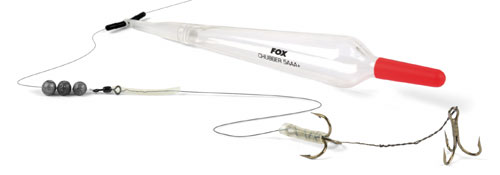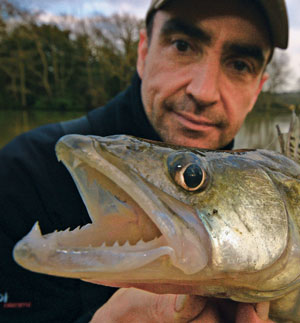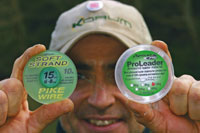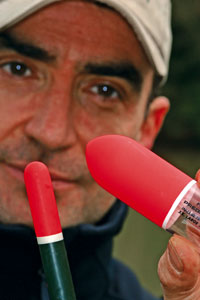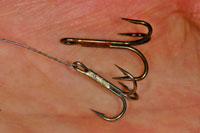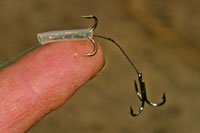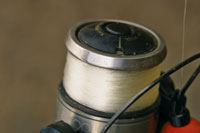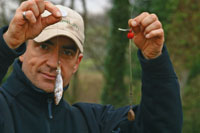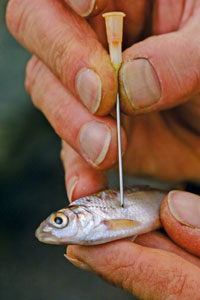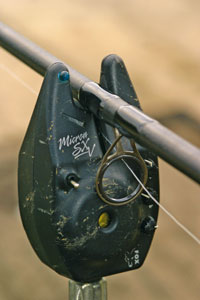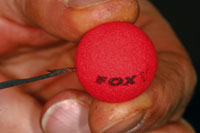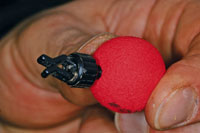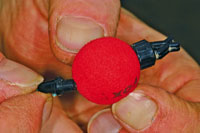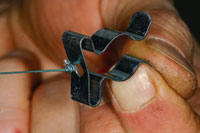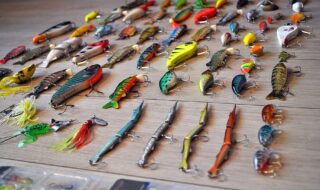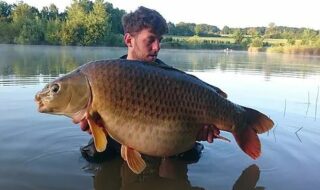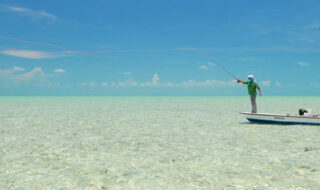Despite their Dracula-like appearance zander are a very shy-biting species and, as Ian reveals, it can take seriously sensitive tactics to tempt them.
An alien predator with Dracula fangs, ‘see-in-the-dark’ eyes, rough scales and spines… No, it’s not a monster from a third-rate B-movie but the zander, one of the most fascinating yet misunderstood species in the British freshwater fauna.
Originating from Continental Europe, the first successful introduction of zander to the British Isles took place in 1878 as the result of collaboration between the Duke of Bedford and the President of the German Fishery Association. Fuelled by the Duke’s fascination with exotic species, the initial shipment was followed by others and a thriving population was soon established in the lakes surrounding his Woburn Abbey stately home.
As far as anglers are concerned the real story started on 18 March 1963 when the Great Ouse River Board introduced 97 zander originating from Woburn into the Ouse Relief Channel, claiming at the time it was a stillwater from which the species could not escape. Fateful words which still echo to this day as zander continue to colonise river and canal systems throughout the UK, both by natural spread and assisted movement ‘with a little help from their friends’.
Blamed for the collapse of the Fenland fisheries and vilified by the media and anglers alike, zander rapidly became the fish they loved to hate and kill on sight, and many clubs instigated cull policies. It’s only in more recent years as populations have stabilised and balanced fisheries have re-established themselves that the true nature of the species and its ecological role within the aquatic environment has become more properly understood.
Despite this newfound understanding, for some anglers they still remain an object of hate. But for predator anglers who enjoy challenging fishing for one of the most interesting species in the UK, they are a worthy target.
There has never been a better time to fish for them either; with good populations in bigger river systems such as the Severn, Warwickshire Avon and lower Thames, ‘zeds’ are more widely available than they have ever been.
My best zander is a Fenland monster topping 13lb and the lowland river, drain and channel systems of the Fens remain the prime area for the species. But for this session I’m heading deep into rural Surrey to one of the premier mixed fisheries in the UK: Bury Hill Fisheries.
The Old Lake on the Bury Hill complex is a 200-year-old Victorian estate water and, being totally enclosed, is one of the few in southern England which has been given consent to legally stock the species.
With a proactive attitude towards predator fishing and sensible fishery rules it is one of the top winter hotspots for toothy action and I’m looking forward to spending a day here, with resident predator expert Eric Bailey on hand to point me at some ‘going’ areas.
For once it’s not an early start and I join Eric for a relaxed cuppa in the clubhouse at 10am before taking a leisurely stroll down to my swim late morning. Unlike pike, which are primarily early morning feeders, zander are specially adapted to feed after dark and a special lining inside their eyes, the tapetum lucidum, gives them brilliant night vision and a massive advantage over their prey species in low-light conditions.
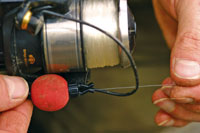 |
| The finished indicator can be attached via the Jubilee clip to the back rod rest and used as a lightweight drop-off indicator clipped onto the line beneath an open bail arm. For how to make Ian’s lightweight zander indicator, see below. |
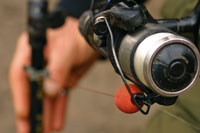 |
| Alternatively, clipped to the front rod rest it acts as a brilliant lightweight bobbin. Pike-style drop-off indicators and arms are just too heavy for zander fishing and it is really worth going to the effort of making your own if you want to get to grips with zeds. |
Cloud is forecast for the afternoon so I’m in no hurry to tackle up in the bright conditions early on and I take my time having a good look around the swim. Eric has indicated the presence of a big patch of lily tubers in front of me and by pulling a light lead across the area I can feel where they are just starting to sprout.
The clear water immediately in front will be ideal for a pack of zander to hunt along and I earmark it for one of my rods.
The second obvious area is the drop-off from the island opposite, always a favoured spot for predators; it’s a decent chuck for light rods and as I’m sizing it up a commotion in the shallows to my right draws my attention.
It’s a small pike getting ready to spawn; this is incredibly early and a sure sign of the creeping impact of global warming on our fisheries. Eric reckons the zeds will be ready to spawn too and that could make predicting location and feeding patterns tricky.
My zander gear bears more similarities to my perch and barbel fishing outfits than it does to my pike tackle, and today I’ve come armed with my Neoteric Twin Tips and matched them up to a pair of small free-spool reels. Line is 12lb Illusion fluorocarbon, the near invisibility of the material underwater making it a must for all sight-feeding species.
For the chuck to the island I’m setting up a free-running rig with my lead on the bottom of a buoyant leger stem to keep my line clear of any bottom debris.
|
|
||||
|
|
I’ve got a wide diameter run ring at the top of the stem to allow for friction-free line movement and the lead is 2.5oz. Many anglers make the mistake of using light leads when trying to minimise resistance, but this is a mistake as they do move and create resistance as the fish picks up the bait. A heavy lead remains firmly anchored to the deck and in the event of a take only the line moves, giving direct indication back at the rod. It’s a vital edge when tackling tricky predators.
On my margin rod I’m going to use a float – there’s no better way to get instant indication of what is happening underwater. My zander floats are much smaller than my pike fishing patterns with short, streamlined bodies and fine tips to minimise resistance. Eric has warned me the going at Bury Hill has been extra tough recently so today I’m going to scale down further still and set up a 5AAA Drennan Chubber.
To maximise indication I’m going to set it overdepth and pinch on three AAA shots just above the trace; by putting the rod in two rests and tightening the line slowly, the under-shotted float will cock under tension, but will lift the second the bait is taken.
My zander traces are scaled-down versions of my pike ones and there’s a big difference between the semi-barbed size 10 Drennan trebles I’m using today and the size 6 and 8 versions I was using for last month’s pike outing! I’m fishing small baits today too, so the upper treble is set just 3cm above the lower and I use a piece of clear silicone as opposed to a black rubber treble protector to sheath it – a small detail, but it can make a big difference with sight-feeding zeds.
Hooking zeds is not easy and with a mouth like a bag of chisels, small, razor-sharp trebles tend to be more effective than larger patterns; the outer areas of the mouth are softer with a thin membrane over bone which gives poor hook holds, often resulting in heartbreaking hook pulls.
To eliminate dropped takes, the trace material needs to be soft and supple and Drennan’s 15lb wire is perfect and nicely coloured for subtle work. Pro Angler wire is worth a look too – it’s so supple you can actually knot it! I twist my zander traces in the same manner as my pike ones with a length of around 45cm about right.
For my Fenland work I favour small livebaits for zander. They take some beating, but livebaits are strictly prohibited on Bury Hill, so this is an all-out deadbait assault. I’m not too concerned by this as zander scavenge effectively and deads will often bring the larger fish. I’ve got a few tricks up my sleeve to give the baits a bit of a boost too.
Unlike pike, which feed on larger prey as they get larger themselves, zander will always tend to select smaller prey and I rarely use anything over 10cm in length. It may seem small, but baits of this size are perfect for the biggest zeds that swim.
I’ve always found sea deadbaits totally useless for zander, but Eric reckons the Bury Hill zeds are partial to a bit of mackerel, so he is going to set up along the bank from me with a smelly lump of mackerel fished in a deep hole. I’m putting my faith in small roach and tail sections of smelt which have produced consistently for me in the past. I’ve not got any with me today, but if you are looking for a decent change bait, eel sections are a good bet. These three offerings are all you need to get the most from any zander fishery in the country.
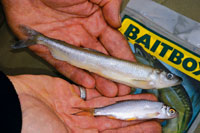 |
| Small dead roach or soft-fleshed smelt are top notch. |
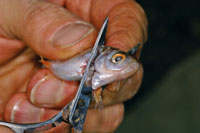 |
| A headless roach is Ian’s number one zander deadbait. The tail end of the smelt is the next best thing. |
By the time I’ve got both baits out the weak winter sun is already beginning to dip below the woodland behind me, casting long shadows across the water. If conditions stay like this there just may be a chance of some early action. The downside is that I have been scanning the water in front of me for ages and there have been no signs of small fish moving or scattering.
Smaller zander tend to hunt in packs and slash through shoals of small fish before going back to pick up the dead and dying ones, and in the process often betray their presence in an area. Looking on the bright side I’m aware the big fish are often loners and there could be a right old lump just waiting for the cloak of darkness before starting to patrol the island drop-off.
My float suddenly lifting and lying flat on the surface disturbs my thoughts – my bait has been picked up! I’m on the rod in an instant, but there is no sign of line movement and the float is lying perfectly still on the surface. I’m used to drops with clumsy zander rigs, but this was an instantaneous pick up and drop on finely tuned gear.
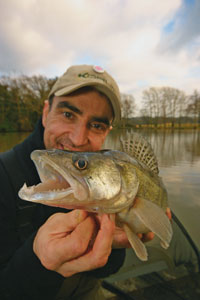 |
| Not a Bury Hill double, but a very welcome four-pounder. |
I inspect the roach closely for tell-tale stab marks but there are none; Eric was right – they are behaving strangely at the moment and I wonder if they want an even smaller and more attractive bait, so I cut the head off my replacement roach, re-cast it beyond the line of tubers and inch it back until I feel the first sign of broken ground.
It looks like I’ve made the right call as an hour later the float lifts again, but this time it starts to slide away. I’m not going to delay the strike as I would with a pike, but snap the bail arm over and wind straight into it – and I’m relieved as the Neoteric bends into a fish. There are none of the splashy acrobatics of a jack pike either; this is the jagging, head-shaking, thumping of a zed!
With a nice fish on the bank during the afternoon my confidence is sky high as the light really begins to fade. I’m certain the island rod is going to produce a special fish and I hover over it willing the bobbin to move.
Finally a bleep on the alarm alerts me, then another as the bobbin starts to lift. The adrenaline is really pumping as I pick the rod up but the line is slack. It’s another drop and with the fishery about to close there won’t be another chance this evening. Eric has struggled next to me too with just a couple of bleeps to show for a hard day’s fishing.
It’s been a real battle of wits today, a game of chess trying to outwit these cute predators as much as a fishing session, and although I’m delighted to have put one on the bank against all odds, I’m conscious of the fact I ended the day 2-1 down.
Back at the clubhouse owner David DeVere tells me early spring tends to bring a more reliable and positive feeding spell. I’ll be back then for the second leg!
|
|
||||
|
|
Ian’s Lightweight Bite Indicator
|
|
||||
|
|
Venue File
Bury Hill Fisheries is at Westcott, near Dorking, Surrey. For details of all of the angling opportunities there contact the estate office on 01306 877540 or check out www.bury-hill-fisheries.co.uk . Predator fishing is only allowed from October 1st to March 31st.
![]()
